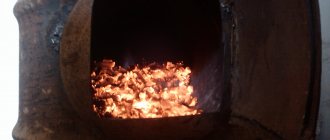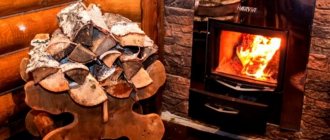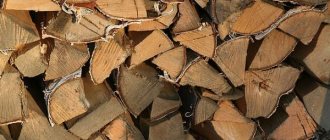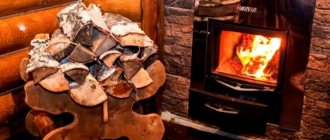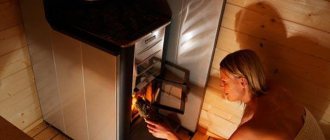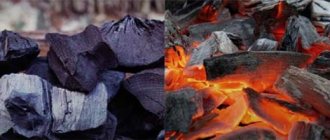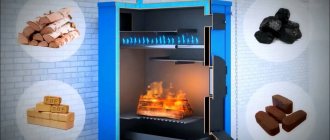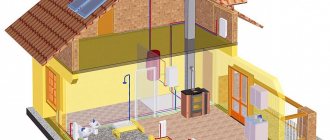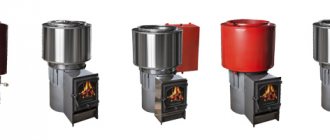With the arrival of cold weather, every owner of a heater or stove asks the question: how to light the stove at home? The diligent owner stocks up on raw materials a year before the heating season. During this time, they dry in a woodpile, where they are protected from rain and snow. The shed should be well ventilated to prevent the wood from rotting.
There are times when you didn’t prepare in advance, but the camera needs to be lit at that moment. You only have imported material that is not prepared for heating a house or bathhouse. You did not have the opportunity to prepare dry dead wood. This is not a reason to be upset, we will look at several methods of ignition.
How to light a stove with raw wood - without special tools
Many people mistakenly think that they can handle raw timber with kerosene, diesel fuel or gasoline. You just have to splash a little liquid into the fireplace. This will lead to fatal consequences, including setting the premises on fire. You can also be poisoned by combustion products if you do not open all windows and doors wide open. There are other ways, you just have to be patient, because the procedure will take a lot of your time:
- It’s good if you have dry logs left over from last year. Then you should first divide them with an ax or knife into thin chips. Crumple up more paper, put prepared torches on it, and light it. Let the fire burn. At this time, prick the wet bars as thinly as possible. And carefully place them on the hearth like a hut. Do not try to speed up the process; do not add all the logs at once. This will lead to smoke in the room, the formation of soot and soot in the pipe. Once the red coals appear, you can place thicker dies there. You just need to make sure that there is a small distance between them to allow oxygen to get into the fire. Next, follow the method: your hand can’t stand the heat over the fire, so it’s time to add the rest.
- How to heat a stove with raw wood? A little harder and longer. Many stokers know from experience that smoke and soot will be present here. But as soon as the first batch of brushwood flares up, you can add wet wood. There will no longer be any difference between dry and wet fuel. The heat transfer from the fire will be the same. Even people deliberately delay the combustion process by throwing raw material into the firebox in order to increase the period of time for adding a new batch. Because dry dies light up quickly, but also burn out instantly. And you will constantly think about maintaining heat in the house, and run to the unit again and again.
Subtleties and nuances
There are some secrets to successfully making fire from wet wood that we would also like to share:
- The worst thing is if you have damp aspen firewood. This type of wood produces a small amount of heat, so aspen firewood will be very difficult to light. The logs will slowly smolder when exposed to temperature, releasing very little heat.
- A good option for quickly kindling raw logs is birch or spruce. Despite the fact that these tree species emit a lot of soot and soot when burned, they are optimal for quick kindling. The fire catches on the chips and birch bark in literally a matter of seconds.
- An original way to quickly dry wood was invented by our ancestors. Salt should be poured in large quantities onto wet firewood. The salt will draw out some of the moisture, and the firewood will become usable.
- If we light a fire in nature and we have flammable liquids in our arsenal, for example, diesel fuel, gasoline, kerosene, then it is quite possible to pour these compounds on the wood chips. If we want to use flammable liquids in the stove, we can moisten a rag with them and place it between the logs. The characteristic odor from such liquids will disappear fairly quickly after lighting a fire.
- Some experts recommend putting an empty bottle of vegetable oil in the firebox. With its help you can quickly get the required amount of fire.
Please note that firewood is always purchased raw. It is best to do this in winter, stocking up for the next season, when equipment easily enters the forest. In this case, you will have the firewood for a whole year before using it. They must be stored in a woodpile, protected from precipitation and blown by the wind.
As you can see, there are no particular difficulties with kindling raw firewood; the main thing is to approach this issue thoughtfully and carry out the preparatory work efficiently. With a little patience, you will have a nice, intense fire that provides warmth.
How to heat a stove with raw wood: basic techniques
First you need to figure out what type of wood is suitable for heating the room. Experts say that non-coniferous wood is best suited for this purpose. Pine and spruce, when burned, release resin, which is deposited on the walls of the chimney. They also do not maintain optimal temperature.
Depending on your geographical location, you choose the timber that grows in the immediate vicinity of you. We will give a brief description of the more relevant categories of raw materials:
- Pine. It has a high degree of combustion, releases a huge amount of resin, and is characterized by internal voids. When ignited, sparks fly and the log explodes into separate pieces.
- Spruce. They heat it when absolutely necessary, as it brings little heat, smokes, and smolders. But it pricks easily.
- Alder and aspen .
If you heat the stove with raw wood from these species, you will solve another problem at the same time. They are the only ones that clean the chimney of tar and soot. - Poplar. The cheapest wood. It does not produce much heat, burns out very quickly, and requires constant presence near the heater. You can’t heat a bathhouse to the optimal temperature.
- Birch. Just like poplar, it burns quickly and has little heat transfer. In this case, a constant flow of air is required, otherwise the birch logs will smoke and not produce heat. It is better not to use wet dies from these rocks, because the released resin will quickly damage your heating system. You will have to call a specialist to clean out the clogged smoke exhaust system.
- Oak. Optimal type for heating. It burns for a long time and produces a lot of heat. The only negative is that it pricks hard when dry. Therefore, it must be processed immediately after felling.
- How to light a stove from an apple, pear or other fruit tree? This question is asked by owners of private houses, summer cottages and garden plots. There is no need to throw away cut logs. They provide excellent heat transfer. In addition, the room is filled with a fruity aroma, which has a beneficial effect on people’s well-being.
- Linden and maple. They are convenient and easy to prepare into bars, but do not produce charcoal when burning, leaving only crumbly ash. And this affects heat transfer. These breeds require special attention from the heater owner; logs need to be added every half hour.
- To heat the living space, you can use peat briquettes and pellets made from pressed sawdust. In Asian countries, dung is widely used.
Procedure for kindling
Experienced stokers don’t have a question: how to quickly light a stove with raw wood? They elevated their work to the level of art. Because they know that wood gives off heat at a temperature of 300 to 400 degrees. And to heat rooms it is not enough to maintain a fire at 50 °C. This will only lead to smoke.
For an optimal kindling process, experts give several recommendations on how to reduce fuel consumption and increase heat:
- It is preferable to prepare raw materials that are five centimeters smaller than the combustion chamber.
- The size of the chopped log should be approximately the same.
- It is necessary to remove all burnt ash and coals from the furnace, and clean the grates from tar and soot.
- Then check for the presence of traction, first light the paper. And look at the direction of the smoke. If everything is in order, then it will go inside the firebox, and not out.
- We begin to make a seed: we place two logs parallel to each other, and between them is a crumpled piece of paper. Sawdust and shavings are poured on top. Two more beams are placed on top of this structure. Next, we set it on fire with the blower open so that there is additional air supply.
- When the heater begins to hum, then close the lid, but not completely.
This method is suitable for dry logs, but how to light a stove with wet wood? Stokers give their recommendations:
- Chop the block lengthwise into several pieces.
- If it is a birch tree, then remove the bark, as it will interfere with the kindling.
- From the inside, pinch the splinters, which are not so wet.
- There should be a large number of such chips. Because they will have to maintain the fire for 15-20 minutes until the firebox warms up.
- Place the prepared splinters in a “hut” on the crumpled paper.
- When the fire is burning properly, you can then add thin dies.
- Wait another twenty minutes, then add the raw logs to the hot coals.
- Cover the vent and monitor the combustion process.
- Don't let the fire go out, otherwise you'll have to do it all over again. Periodically add wood to the flame.
- Watch the draft so that smoke does not enter the room.
Why damp and wet firewood does not ignite
How much worse is damp firewood ? This issue worries many, if not all. There is an opinion that wet firewood is worse in terms of calorific value than dry firewood. From my own experience I will say that damp firewood
burn very badly.
From a conversation on a construction forum: – If stove on dry wood heated the room up to 20 degrees, then on wet wood it barely reached 15. And, the burning time is still the same (if you count by the number of firebrands). A very good option (if there is no dry firewood) is to dry the fuel directly by the stove, at least for a couple of days. The effect is very noticeable. If there is absolutely no dry firewood, you have to dilute it slightly dried, and then add it in its raw form
.
Damp wood poorly, but for a long time. They heat at half strength, but they burn longer. Why this is so is not clear. – The energy (heat) of wood combustion is spent on heating the excess moisture (water) contained to the boiling point and evaporation of this water
Calculation of mass calorific value of raw firewood
In order to once and for all clarify for myself the topic of calorific value for damp and wet firewood, I found a calculation method on one of the forums, took out a school textbook and sat down to count. This is what came out:
Estimated weight of firewood is 1 kg, incl. - dry combustible wood substance 0.8 kg - water 0.2 kg
Heat of combustion of wood 4752.9 kcal/kg x 0.8 kg = 3802 kcal
Let's calculate the heat that water (0.2 kg) will take when heated to 100 degrees, and then - to transform into steam and heat the steam to a temperature of 800 degrees:
Heating water from 20 to 100 degrees: 1 kcal/kg°C x 80°C x 0.2 kg = 1.6 kcal Steam formation: 0.2 kg x 539 kcal/kg = 108 kcal Steam heating: 0.2 kg x 700°С x 0.51 kcal/kg°С = 71 kcal
As a result, 3802 - 1.6 - 108 - 71 = 3621 (kcal)
For firewood, with a relative humidity of 40% (wet firewood
)
Estimated weight of firewood is 1 kg, incl. — dry combustible substance 0.6 kg — water 0.4 kg
Heat of combustion of wood 4752.9 kcal/kg x 0.6 kg = 2852 kcal
Let's calculate the heat that water (0.4 kg) will take when heated to 100 degrees, and then - to transform into steam and heat the steam to a temperature of 800 degrees:
Heating water from 20 to 100 degrees: 1 kcal/kg°C x 80°C x 0.4 kg = 3.2 kcal Steam formation: 0.4 kg x 539 kcal/kg = 216 kcal Steam heating: 0.4 kg x 700°C x 0.51kcal/kg°C = 143 kcal
As a result, 2852 - 3.2 - 216 - 143 = 2490 (kcal)
For firewood, with a relative humidity of 60% (very damp, freshly cut firewood)
Estimated weight of firewood is 1 kg, incl. — dry combustible substance 0.4 kg — water 0.6 kg
Heat of combustion of wood 4752.9 kcal/kg x 0.4 kg = 1901 kcal
Let's calculate the heat that water (0.6 kg) will take away when heated to 100 degrees, and then when it turns into steam and heats the steam to a temperature of 800 degrees:
Heating water from 20 to 100 degrees: 1 kcal/kg°C x 80°C x 0.6 kg = 4.8 kcal Steam formation: 0.6 kg x 539 kcal/kg = 323 kcal Steam heating: 0.6 kg x 700°C x 0.51kcal/kg°C = 214 kcal
As a result, 1901 - 4.8 - 323 - 214 = 1359 (kcal)
When analyzing the calculation results, the following becomes clear:
- The group calorific value of room-dry and freshly cut firewood varies by more than two times
- A decrease in the mass calorific value of firewood occurs, as a rule, due to a decrease in the weight fraction of dry combustible matter per unit mass of fuel. Heat losses for heating and steaming water, as well as for heating superheated steam, are relatively small. Based on this, 180, 362 and 542 (kcal). Of the total mass calorific value of completely dry wood (4752.9 kcal/kg), this is (only) 3.7%, 7.6% and 11.4% for relative moisture of 20%, 40% and 60%.
- Still, wood with a humidity of 60% almost does not burn. What a 11.4% heat loss here. Clearly, there is something different here. Right now, let's try to get to the bottom of it.
- The only reassuring thing is that approximately the same figures were obtained using a completely different method for calculating the calorific value of wood. This suggests the plausibility of the results and the chosen path.
Yes! In mass units, some unconvincing calculation emerges. What if we repeat everything for volumetric units?
Calculation of volumetric calorific value of raw firewood
To calculate the volumetric calorific value of firewood of different moisture content, let’s take oak firewood
with a density of 0.81 kg/dm 3 and a calorific value of 3240 kcal/dm 3 , with a moisture content of 12% (see Table of the specific calorific value of wood for various wood species). Suppose there is a batch of firewood with a volume of each log of 1 dm 3 and a weight based on this is 0.81 kg each (for ease of calculation). It is quite clear that each such log contains the same amount of dry combustible substance (0.81 kg in each). Moreover, this amount of flammable substance remains constant, even if a log is soaked in water for a long time. And if the amount of flammable substance is the same in dry, wet, and wet logs, then their calorific value will also be the same.
Nobel Prize for calculating the calorific value of raw firewood
The conclusion is frankly worthy of a Nobel Prize! Volumetric calorific value and crude
and dry wood - the same. As a rule, this is so, if you recall the designation for high and low calorific value of wood. The heat that is needed to heat and evaporate the water present in wood is called the latent heat of combustion. The heat required to remove water from wood during combustion is the famous difference between gross and working calorific value.
In the case of volumetric calorific value (as opposed to mass), when the moisture content of firewood changes, its volume does not change. Water is simply absorbed into the voids of the wood, but at the same time the volume of combustible wood substance does not change. Then, during the burning of wood, this water will be evaporated and released into the atmosphere. Likewise, the volumetric heating value of wet firewood is equal to the volumetric heating value of dry firewood minus the latent heat of combustion required to remove water from the wood.
In our case, with oak firewood:
From the total calorific value of dry oak wood (0% moisture content)
4752.9 kcal/kg x 0.81 kg/dm3 = 3849 kcal/dm3
it is necessary to subtract the latent heat of combustion required to remove water from the tree, which is calculated based on the degree of its moisture.
Another Nobel Prize for calorific value calculations
Let us make sure that we are right by means of extreme modeling of the situation.
— Suppose we were able to wet our oak log (volume 1 dm 3 ) to such a state that it absorbed 1 dm 3 of water. Then, the calorific value of wood from such super-wet oak will be:
The heat of combustion of wood is 3849 kcal/dm 3 minus the heat that water will take (1 dm 3 = 1 kg) when heated to 100 degrees, with further evaporation and heating of the steam to a temperature of 800 degrees:
Heating water from 20 to 100 degrees: 1 kcal/kg°C x 80°C x 1 kg = 80 kcal Steam formation: 1 kg x 539 kcal/kg = 539 kcal Steam heating: 1kg x 700°C x 0.51 kcal/ kg°C = 357 kcal
As a result, 3849 - 80 - 539 - 357 = 2873 (kcal)
Well, the result was good.
There are still quite a lot of calories left to support combustion and evaporation of the second liter of water. It turns out that if we could wet oak firewood to an incredibly fantastic degree such that 1 dm 3 of wood absorbed 2 dm 3 of water, then such firewood would be able to burn. In other words, wood of any moisture should burn hot and bright, even directly in the water mass?
Regardless of the absurdity of the task conditions, a stupid result is also a result. In order not to subscribe to his idiocy, the author will immediately stop distorting the theory of combustion and take it as a theorem:
- 1dm 3 oak firewood is enough to heat 2 liters of water to a temperature of 100°C, evaporate it and then heat the resulting steam to 700°C (under 50% fireplace efficiency conditions)
- 1dm 3 oak firewood, with a humidity of 70%, has approximately 0.56 liters of water. Such firewood cannot burn on its own. Proved by practice.
Why do damp firewoods not ignite (burn poorly)?
Due to the fact that the wood itself does not burn directly (does not oxidize). Only the products of thermal decomposition of wood - pyrolysis - burn (oxidize). The first signs of the process of thermal decomposition of wood (pyrolysis) appear at 400–500°C. For stable pyrolysis, a temperature of 700.900°C is required. To start pyrolysis, the wood must be heated to the pyrolysis temperature from an external heat source (set on fire). If there is no heat loss in the high-temperature pyrolysis zone, the wood will ignite and burn. The high-temperature pyrolysis area will warm up adjacent areas of wood and move towards them. Wood burning will occur in the same way.
Now, our water. Water in wet wood is found in pericellular and intracellular voids. That is, water in raw
wood is located directly in the high-temperature pyrolysis zone and cools it. Until the water has evaporated from the wood, it is impossible to heat it to 400.500°C, much less to 700.900°C. Similarly, the vaporization of water from the wood layer is a mandatory process that precedes the pyrolysis of wood and the combustion of pyrolysis products. And before that, wood was simply a non-flammable substance, so to speak. However, this is only half the problem.
After the water evaporates, the superheated vapors mix with the gaseous products of wood pyrolysis and cool them down. There is much more water damage here. If in the case of water evaporation we are talking simply about heat loss, then when mixing water vapor with gaseous pyrolysis products, we are talking about a direct loss of an expensive combustible substance. Due to the fact that combustion (oxidation) of gases occurs on a thin line between its heated volume and the surrounding air, which contains oxygen. Superheated vapors, mixing with flammable gases, lower their concentration and temperature, and help remove them from the combustion zone in an unburned (non-oxidized) form. Saturated white smoke from damp firewood is nothing more than superheated vapor mixed with unburned gas generator gases.
How to burn raw wood
In reality, not everything is so bleak. Damp firewood can cause a lot of inconvenience when lighting a fireplace. There is smoke, soot, and little heat. However, if the hearth has flared up perfectly, then there is almost no difference between the calorific value of dry (20..30%) and wet (30..40%) firewood. Some stokers do this: they ignite with dry wood, and then lay down wet wood . This is done to stabilize the combustion process and subjectively increase the time intervals between adding firewood. Thanks to the fact that – dry firewood
they quickly flare up and burn out, and raw ones smoke for a long time and tediously. However, according to Comrade Zimin, this is a completely different story.
How do wet wood burn?
\
How to speed up kindling
Many hunters give advice on how to quickly dry firewood. They saved more than one frozen life in extreme conditions. There are prepared woodpiles in the parking lots, only in the open air, where rain falls on them. Accordingly, during winter, they freeze and become covered with ice. But this does not prevent hunters from warming up. They use several old folk techniques:
- It is necessary to clear the lumber of snow.
- Chop into small slivers.
- Melt the unit, as we wrote earlier.
- Just throw two handfuls of coarse table salt onto the paper. It will absorb excess moisture.
- If you don’t have a newspaper at hand, take a piece of plastic or roofing felt. You will spend a little more time lighting these items.
- If this is not the case, then vegetable oil will help you. You can pour a tablespoon onto the wood chips. Or fill a liquid bottle with sawdust, shavings, newspaper or dry rags. And also put it in the fire.
- Use diesel fuel and gasoline. But there is no need to splash them into the combustion chamber. You need to soak a piece of rag in the liquid and place it next to the wood chips. Then you will avoid a fire hazard.
Of course, you can suffer for a long time with an old heater or stove, but in the end you will achieve results. But will it give you all the heat, will it be reliable in operation, will it withstand the load of wet wood? Before building a house with stove heating, you should contact specialized stores for advice.
How to quickly dry firewood
If you did not take care of the preparation of logs in advance, and you need to heat the constructed structure right now, then you can get out of the situation:
- The raw material is sawn and split to the size needed for your system.
- We stack the finished dies next to or above the heating structure so that air easily circulates between them (a well or a thin layer).
- Please remember that the drying material may ignite! Therefore, safety precautions must be observed. Direct contact with very hot parts of the heating device must not be allowed. A tree can catch fire even at a distance from infrared radiation!
- Such actions will allow you to quickly solve the ignition problem.
- Logs, without direct contact with precipitation, dry in wet autumn and severe frosts. The conclusion from this is to store logs indoors.
- Soft woods such as pine, spruce, aspen, and poplar are most suitable for ignition. It must be kept in mind that they burn very poorly when wet. But they are easier to dry than oak, ash or birch.
How to heat a raw wood stove: important techniques
Dry firewood is the main component of a successful combustion chamber for any stove, even the most obstinate one. They flare up quickly, providing a stable flame. All that remains is to add new logs and stir the formed coals. However, for certain reasons, dry firewood may not always be available, and wet firewood contains a lot of moisture and does not ignite.
We suggest you familiarize yourself with How to mix cement mortar to fill holes. How to mix cement with your own hands correctly and in the right proportions
Nuances of ignition
Our ancestors also advised that anything that burns can ignite a heating unit. Take the materials that you have available: hay, straw, old newspapers and magazines, birch bark from sawn dies, plastic dishes, plastic bottles, sawdust and shavings.
By the cold season, you should carefully check the condition of your stove, clean the chimney of last year's soot, remove ash and old coals from the furnace, check the serviceability of the grate, and check the draft with lit paper. Make sure your latches and lids open and close smoothly, so there are no unnecessary gaps. Only after all the manipulations can you begin the heating process.
Lighting a heater or stove does not require fuss or acceleration. Be patient, otherwise you will not only have to sit near the unit for a long time, but also ventilate the entire room from carbon monoxide. If you lit a “hut” of wood chips and started to smoke, do not panic. Open the ash pit, close the firebox and wait until the accumulated smoke stops the fire and leaves through the hole, simultaneously warming up all the pipes. After a few minutes, try again, just add more dry material. Alder or aspen are best suited for cleaning a chimney, as they will help burn off last year's resinous deposits. When the combustion has stabilized and draft has appeared, you can start laying wet firewood. Just watch the intensity of the fire so that the water does not extinguish it.
You must remember that the filling of the firebox at the initial stage does not exceed 30 percent of the volume of the chamber itself. After the temperature of the brick becomes optimal, that is, the heater is warm at hand, you can add wet logs every 2 hours. In this case, it is strictly forbidden to close the damper and vent completely. They should be slightly open to increase the heating time.
